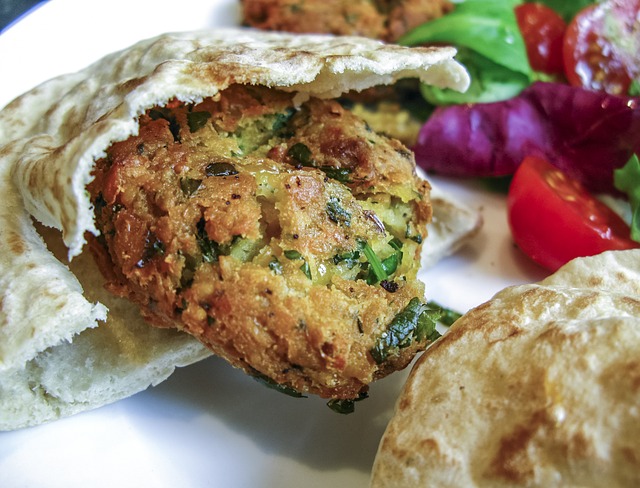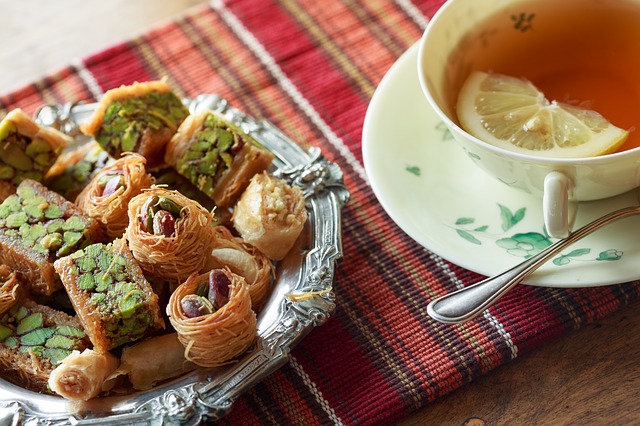Arabic cuisine refers to a style of food with traits shared by populations living in rather large geographical areas in Middle East, between the Atlantic Ocean and the Mediterranean Sea, the Indian Ocean and sub-Saharan Africa, in several countries including Iraq, Yemen, Morocco, Egypt, Lebanon, Syria, Palestine and so on.
Islamic Precepts
The Islamic religion provides for Muslims a series of food bans derived from the Koran. Foods are divided into halal, which means “according to the law”, and haram , which means “against the law”. Alcohol, blood is prohibited, meat of carnivorous or omnivorous animals, including notoriously pork and its derivatives, including lard, contained for example in some types of bread. The consumption of donkey meat, birds of prey, mice, reptiles and amphibians is also prohibited. As for fish, fish with scales is definitely halal, while the position regarding fish without scales or crustaceans varies.
Allowed animals must be slaughtered according to the Islamic rite (or Dhabiha) that is to say by an experienced Muslim, through the clean cut of the throat, cutting the trachea and jugular veins with a single blow, after having pronounced the name of Allah. After slaughter the blood it must be completely eliminated. It is forbidden to consume animals that have died or been killed in any other way, for example mauled by other animals, precipitated or killed by hunting. During the year there is a period of fasting and purification lasting 40 days (Ramadan) during which it is forbidden to eat and drink from sunrise to sunset.
Basic Foods
Cereals and legumes

Rice is used as a basic ingredient in the preparation of various dishes including desserts, for example various types of puddings. Wheat is used above all for bread or in the form of semolina, as a basic ingredient of cous-cous of Berber origin. The bulgur is a derivative of durum wheat which is cooked to the steam, dried, and then coarsely ground in order to obtain fragments of different sizes; it is used in soups, stews and salads, such as tabbouleh. A typical leavened bread is pitaround in shape. Legumes are very popular, especially lentils, chickpeas and broad beans, at the base of various preparations. For example, the Ful medames, is prepared with mashed beans, oil and garlic, the kushari with lentils, chickpeas, rice, spicy tomato sauce and fried onions. Chickpeas are used in the preparation of vegetable meatballs ( felafel ) or sauces ( humus ), mixed with herbs and spices including cumin and coriander or tahini (sesame seed sauce).
Meat
The most used meats are those of sheep origin and poultry, but beef and sometimes camel are also consumed. Pork is excluded, prohibited by religious precepts. The meats are frequently cooked in the form of stews with vegetables or on the spit (kebab).
Milk and derivatives
Given the poor shelf life of milk, products obtained by fermentation such as yoghurt and cheeses are very popular. The most popular yoghurt is called labneh in Arabic. Similar to Greek yogurt or dahi from India, it is filtered into homemade preparations, through a layer of gauze or light cloth. In this way the buttermilk is eliminated and the final product has a particular compactness. Often the concentration process is also induced by pre-boiling the milk, in order to evaporate a portion of water. Labneh is eaten fresh, often seasoned with oil, spices and herbs or used in the preparation of various sauces and other savory and sweet dishes, also because it resists cooking without decomposing.
Vegetables and Fruits
Several varieties are used. Many recipes include tomatoes, cucumbers, eggplants, okra and potatoes. Vegetable-based dishes stuffed with rice and / or meat are common. Fruit is very popular, with large consumption of citrus fruits, melons, watermelons, grapes, dates, figs, raisins and oily dried fruit (peanuts, walnuts, pine nuts, almonds or pistachios, also used as a filling for various sweets).
Spices and Herbs
Cumin, turmeric, saffron, cinnamon and sesame seeds are widely used. In particular, cinnamon and saffron are among the ingredients of salty and sweet foods and also of drinks. Among the herbs, a great deal of use is made of thyme and mint. The latter is also used in the preparation of tea (especially with mint). The zaatar indicates both a mixture of spices is a set of herbs including hyssop officinale, marjoram, oregano, thyme and mint that is added as a flavoring agent to yogurt, humus, to ‘ oil , bread and so on. The red zaatar variant is composed of thyme and pulverized sumaco drupes that give the particular coloring.
Seasonings
The oil is the predominant condiment, often flavored with garlic, lemon, spices and herbs.
Drinks
Frequent consumption of citrus and other fruit juices. Tea and coffee are served before or after meals, but also between meals.
Characteristics of Arabic Cuisine

The cuisine of the Middle East world originates from the traditions of nomadism and makes extensive use of meat, milk and derivatives, sheep fat, cereals (especially oats, dates and oily dried fruit). The subsequent expansion and settlement of populations greatly enriched the culinary tradition. The habit of eating meat remains, generally prepared in pieces, in the form of stew or ground to make meatballs.
Very strong is the Persian influence from which the use of dried fruit (almonds, walnuts and pistachios fragmented or pulverized, for the preparation of savory dishes, sauces and desserts), sour fruit (pomegranates or lemons, for the preparation of sweet and sour dishes) and spices, imported from China and India. Other influences derive from Egypt, Greece, Turkey and the Maghreb (Berber) populations.
Several meals are planned during the day. Breakfast takes different forms: from the consumption of coffee and sweets, to that of spiced yogurt or cream or, again, of bread seasoned with oil and herbs and even of strong dishes based on legumes (lentil soup, shorbat adas or mixtures of beans and chickpeas).
Lunch, where tradition persists, is eaten with the family and represents the most important meal of the day. In general it serves a main dish of meat stewed with vegetables, variously spiced, served with rice or other cereals, bread and fresh vegetables. The food is placed in a large tray placed in the center of the table or placed on a perch or on the carpet from which everyone serves.
People typically sit on cushions, low stools, or sofas. Tradition provides that no cutlery is used, except for soup spoons, and that food is brought to the mouth with the first three fingers of the right hand, avoiding the use of the left hand, which is considered impure.
Dinner can be similar to lunch or lighter and consist, for example, of bread with cheese or olive oil and herbs, or kebabs or other meat, ending with fruit or sweets. The mezzè, spread from Turkey to the Balkans, to the Middle East, are small appetizers or “between meals”. The word, of uncertain etymology, could derive from the Persian maza (flavor) or from the Arabic mazmiz (small mouthful). Many foods can act as mezze, the most typical are hummus (sauce smoothies chickpeas with oil sesame and lemon juice), fattoush (salad), falafel (balls of spicy chickpeas), taboulleh (made from bulgur, tomatoes, olive oil of olive, lemon juice and mint) or baba ghanouj, made with grilled aubergines.
During Ramadan the culinary tradition is enriched. The dinner consumed at sunset, called futùr (breaking of fasting), requires that you first eat an odd number of dates, according to the Prophet’s habit, then a soup (these foods allow a supply of simple sugars, of rapid absorption, and a replenishment of liquids, necessary since during fasting it is not allowed not only to eat but not even to drink), followed by a main course.
